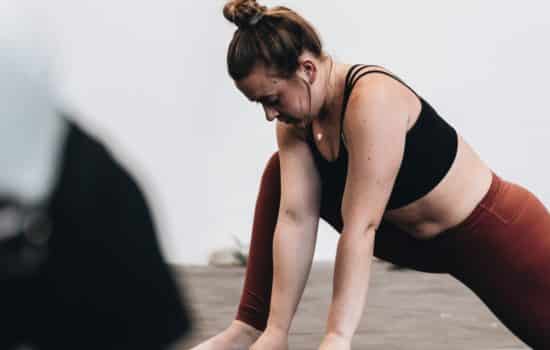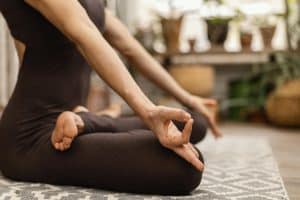Yin Yoga is a style derived from Hatha Yoga, in which the postures are held in a relaxed manner between 2 and 5 minutes. Yin Yoga focuses on stretching the connective tissues of the body, such as ligaments, tendons and fascia, rather than working the muscles. This promotes flexibility and joint mobility, while calming the mind and reducing stress.
What is Yin Yoga?
Yin Yoga is a passive form of Yoga that aims to work with the connective tissue, such as joints, tendons and, very importantly, fascia. Unlike other forms of Yoga that focus on active movement and muscle strengthening, Yin Yoga takes a more gentle and meditative approach. We fully understand that you are wondering what yin yoga is, as it is a little known term. In this blog, we will try to explain what it is, its benefits and examples of postures.
Yin Yoga postures are mainly passive and relaxing in nature. They are performed lying on the floor and are held for one to five minutes, or sometimes longer, allowing to enter the connective tissues of the body and not the muscle groups. This means working with the force of gravity and letting go, rather than active muscular force.
What differentiates Yin Yoga from other Yoga practices? Its focus on deep, sustained stretching of connective tissues, rather than dynamic postures involving repetitive movements. This makes Yin Yoga especially effective for improving flexibility and joint mobility, as well as calming the mind and reducing stress through the practice of mindfulness during the postures.
Yin Yoga What It Is
So, what is yin yoga? It seeks to bring together the process of meditation, peace and connection with oneself, through gentle movements that allow working the joints, tendons and fasciae. Through low-effort exercises, it allows us to work those areas of our body through relaxation.

What are the benefits?
- Provides stability and flexibility to joints and muscles.
- Unblocks, calms and balances emotionally.
- Helps to relax our central nervous system.
- It is suitable for any age and physical condition.
Yin Yoga offers a number of physical and mental benefits. Some of the benefits of Yin Yoga include improving flexibility, increasing blood and lymphatic circulation, reducing stress and anxiety, improving concentration and promoting restful sleep. In addition, Yin Yoga can be beneficial for people with injuries, as it provides gentle, deep stretching without putting too much stress on the joints.
Yin Yoga Benefits
Practicing Yin Yoga regularly can provide a wide range of benefits that encompass physical, emotional and spiritual well-being. In addition to releasing accumulated tension in the body and relaxing the muscles, Yin Yoga can offer significant health benefits. Among these benefits, the following stand out:
1. Release of Physical Tension: Yin Yoga, by involving postures held for longer periods of time, allows for the release of accumulated tension in the deep layers of the muscular and connective tissues. This can help improve flexibility and mobility, thereby reducing the risk of injury and improving body posture.
Stress and Anxiety Reduction: By focusing on the breath and awareness of the present moment, Yin Yoga becomes a powerful tool for managing stress and anxiety. Through regular practice, one can cultivate a greater ability to remain calm in stressful situations, thus promoting an overall sense of emotional well-being.
3. Promotion of Inner Peace: By allowing us to enter into states of deep relaxation and meditation during the postures, Yin Yoga facilitates access to an inner space of calm and serenity. This practice can help calm the mind, reduce emotional turmoil and promote greater inner balance.
4. Improved Body Awareness: Yin Yoga invites a greater connection with the body and the physical sensations present in each moment. This improved body awareness can translate into greater mindfulness in daily life, allowing for more conscious decisions aligned with the needs of the body and mind.
Benefits of Yin Yoga
Yin Yoga is a holistic practice that encompasses a wide variety of physical, mental and emotional benefits. Integrating this gentle yet profound form of yoga into your daily routine can have a significant impact on your health and quality of life. Some of the benefits of Yin Yoga include a noticeable improvement in flexibility, an effective reduction of stress and anxiety, a more harmonious energy balance, improved sleep, and the promotion of self-acceptance and self-awareness. This practice is a valuable tool for cultivating a more balanced and healthy life in all aspects.

Yin Yoga Postures
There are many Yin Yoga postures, but the important thing is that is not to work the muscles, but rather to target the ligaments, tendons and fasciae, which are the connective tissues that support and stabilize the joints. Holding the postures for an extended period of time provides a gentle, but deep stretch on these tissues, which can help improve flexibility, joint mobility, and blood and lymphatic circulation. Here are the 20 Yin Yoga postures.
How long are the Yin Yoga postures held?
In our Yin Yoga sessions, we immerse ourselves in postures that are held for 3 to 5 minutes, facilitating deep relaxation. To enhance this effect, we encourage you to adopt a 1:2 breathing rhythm, where the exhalation doubles the duration of the inhalation. This technique activates the Parasympathetic Nervous System, responsible for inducing calm and body relaxation, preparing you for a good night’s rest.
It is essential to remember that Yin Yoga is not about forcing the postures. It is essential to maintain awareness and be attentive to sensations and energy. You may feel some tension, which is completely normal. Try to gently relax the muscles as much as possible. Remember that muscle tension can also generate mental activity, counteracting the benefits of the practice.
A timely suggestion is to perform this sequence before going to bed. This gentle preparation will help you immerse into a deep and restful sleep, allowing your body and mind to fully relax.
The 20 Yin Yoga Postures
Below, we share with you the 20 postures of Yin Yoga, in order to begin this process of connecting with your body. These 20 postures will help you have a base to start from. Please note that at Bwell we conduct guided Yin Yoga sessions.
-
Child’s Pose (Balasana): This gentle and comforting posture stretches the lower back, shoulders and hips, while helping to calm the mind and relieve stress.
-
Dragon Pose (Utthan Pristhasana): This variation of the lizard pose deeply stretches the hip flexor and inner thigh, providing relief from stiffness in the hip and groin.
-
Toad Pose (Mandukasana): This pose opens the hips and stretches the inner and outer thighs, helping to release tension in the lower back and hips.
-
Butterfly Pose (Baddha Konasana): This pose opens the hips and stretches the groin and inner thighs, promoting flexibility and releasing tension in the lower back.
-
Needle Thread Pose (Sucirandhrasana): This posture stretches the muscles of the hips and lower back, relieving tension and improving flexibility in this area.
-
Swan Pose (Eka Pada Rajakapotasana): This variation of the pigeon pose deeply stretches the hip flexor and quadriceps, while opening the chest and shoulders.
-
Cat Pose (Marjaryasana): This dynamic and gentle posture helps to stretch the spine and release tension in the back and shoulders.
-
Cobra Pose (Bhujangasana): This posture stretches the front of the body, including the abdominal muscles, chest and shoulders, helping to improve posture and relieve back pain.
-
Turtle Pose (Kurmasana): This posture stretches the muscles of the back and shoulders, while helping to calm the mind and relieve stress.
-
Viper Pose (Viparita Salabhasana): This variation of the lobster pose stretches the front of the body and strengthens the lower back, helping to improve posture and relieve back pain.
-
Crocodile Pose (Makarasana): This relaxing pose stretches the lower back and shoulders, while helping to calm the mind and relieve stress.
-
Dolphin Pose (Ardha Pincha Mayurasana): This variation of the downward facing dog pose stretches the shoulders and the back of the legs, while strengthening the arms and upper body.
-
Crab Pose (Matsyasana): This posture opens the chest and lungs, stretching the front of the body and relieving tension in the shoulders and neck.
-
Lizard Pose (Utthan Pristhasana): This variation of the lizard pose deeply stretches the hip flexor and inner thigh, providing relief from stiffness in the hip and groin.
-
Hero’s Pose (Virasana): This posture stretches the knees, thighs and ankles, while opening the hips and chest, promoting flexibility and relieving stiffness in these areas.
-
Eagle Pose (Garudasana): This posture stretches the shoulders and upper back, while improving balance and concentration.
-
Staff Pose (Dandasana): This posture stretches the muscles of the back of the legs and lower back, relieving tension and improving posture.
-
Warrior Pose (Virabhadrasana): This posture stretches the muscles of the legs and arms, while strengthening the core and improving balance and concentration.
-
Mountain Pose (Tadasana): This posture aligns the spine and stretches the entire body, improving posture and promoting a sense of stability and inner strength.
-
Leaning Hero’s Pose (Anjaneyasana): This variation of the warrior’s pose deeply stretches the hip flexors and quadriceps, while opening the chest and lungs, promoting flexibility and relieving stiffness in these areas.
These are the 20 Yin Yoga postures that will allow you to get started, practice the most popular postures and perfect your technique.
Please note that you will find examples of how to perform these postures correctly on the internet. It is important to follow the steps for a correct exercise and to notice all the benefits of Yin Yoga.
The 20 Yin Yoga postures that we share with you are just a start, you can find more. At Bwell Clinic, we have a teacher specialized in Yin Yoga who will guide you through the postures.

Yin Yoga Barcelona
Bwell Clinic in Sarrià, Barcelona, will guide you in a unique experience of relaxation and wellness with our Yin Yoga classes. In a world full of constant movement, Yin Yoga invites you to slow down, find inner calm and restore harmony between body and mind.
Led by experienced and passionate instructors, our Yin Yoga Barcelona classes will guide you through gentle and deep postures that are held for extended periods of time, allowing the connective tissues to gradually relax and strengthen. This meditative and therapeutic approach not only improves flexibility and mobility, but also helps you release accumulated tension, reduce stress and promote restful sleep.
In a cozy and peaceful environment, we invite you to disconnect from the daily hustle and bustle and connect with yourself as you immerse yourself in the transformative practice of Yin Yoga. Whether you are a curious beginner or an experienced practitioner, our classes are designed to suit all levels of ability and fitness.
Come and join us at the Bwell Clinic to discover the countless benefits of Yin Yoga Barcelona.
At Bwell Clinic we want you to try new things, that’s why we want to offer you a totally free yin yoga class. Request it here: CONTACT US.
If you would like more information or have any questions, please do not hesitate to contact us by calling us at 931 282 112 or writing to info@bwellclinic.es.
Pages that may interest you: Body Psychotherapy, Sports Physiotherapy, Yoga and Pilates. Yin Yoga.
